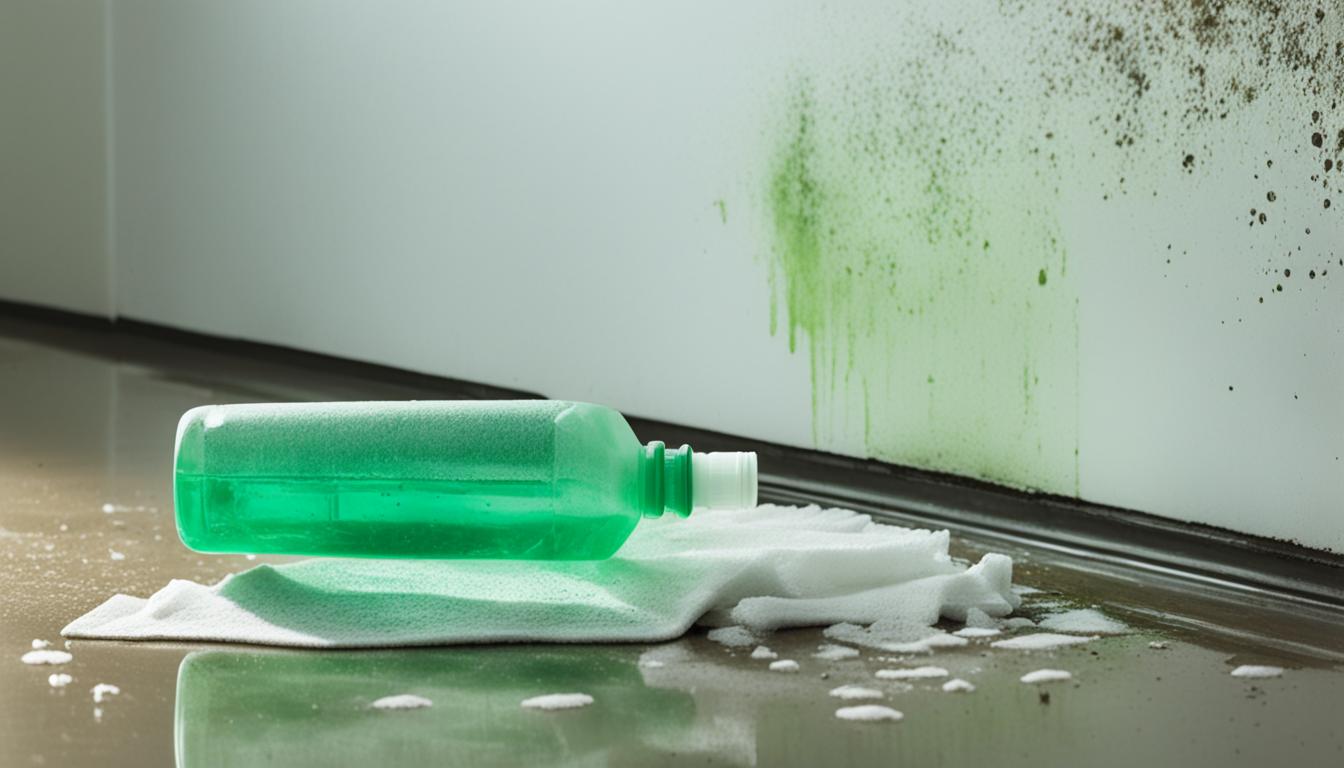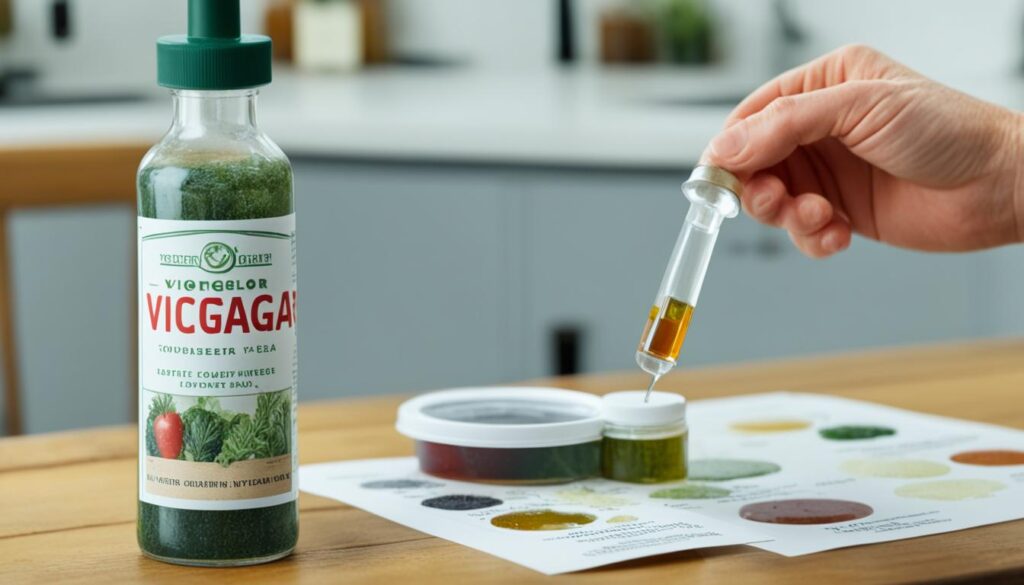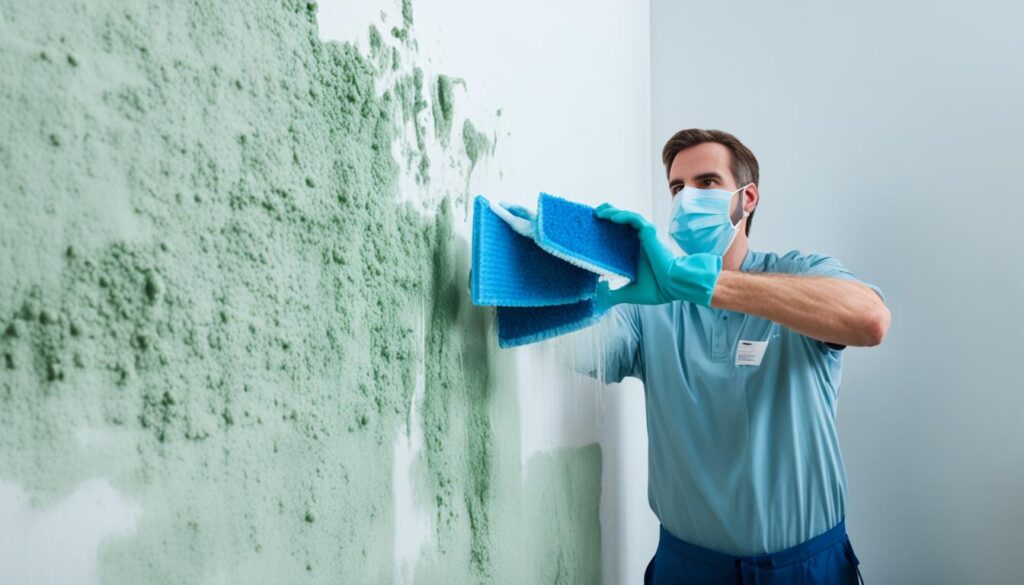
Eradicate Wall Mold with Vinegar: A Guide
Welcome to our comprehensive guide on cleaning mold off walls with vinegar. If you’re dealing with mold issues in your home, you’ll be pleased to know that vinegar, a common household ingredient, can be a powerful ally in your battle against mold. Not only is vinegar an effective mold remover, but it’s also safe, natural, and affordable.
In this guide, we’ll take you through the step-by-step process of using vinegar to eliminate mold from your walls. We’ll cover everything from understanding mold growth and choosing the right vinegar, to preparing the cleaning solution, applying it to the affected areas, and preventing mold regrowth.
Throughout each section, we’ll provide you with practical tips and insights to ensure the best possible results. By following our guide, you can tackle mold problems head-on and create a healthier living environment for you and your family.
Now, let’s dive in and discover how vinegar can become your go-to solution for cleaning mold off walls.
Key Takeaways:
- Vinegar is an effective and safe method for removing mold from walls.
- Understanding the causes of mold growth helps prevent it from recurring.
- Choose the right vinegar with the appropriate acidity level for optimal results.
- Proper preparation of the cleaning solution and wall surface is essential.
- Thoroughly apply vinegar to mold-infested areas, including hard-to-reach spots.
Understanding Mold Growth on Walls
Mold growth on walls is a common issue faced by many homeowners. Not only does it create unpleasant odors and stains, but it can also have detrimental effects on indoor air quality and pose health risks to occupants. Understanding the causes of mold growth on walls is essential to effectively prevent its recurrence and maintain a clean and healthy living environment.
The Causes of Mold Growth on Walls
There are several factors that contribute to mold growth on walls:
- Prolonged exposure to moisture: Excessive moisture due to leaks, condensation, or high humidity levels creates an ideal environment for mold to thrive.
- Poor ventilation: Insufficient airflow and inadequate ventilation can lead to moisture buildup, creating conditions favorable for mold growth.
- Water damage: Any form of water intrusion, such as flooding or plumbing leaks, can initiate mold growth if not promptly addressed and dried.
Health Risks Associated with Mold
Mold growth on walls can have adverse effects on the health of individuals living in mold-infested spaces. Exposure to mold spores in the air can trigger allergies, respiratory issues, and even aggravate asthma symptoms. Individuals with weakened immune systems may be more susceptible to the harmful effects of mold.
Preventing Mold Growth on Walls
While using vinegar to clean mold off walls is effective, it is crucial to address the underlying causes of mold growth to prevent its recurrence. Here are some preventive measures:
- Address moisture issues: Repair leaks, improve ventilation, and maintain appropriate humidity levels to minimize moisture buildup.
- Inspect and maintain the building envelope: Regularly check for any signs of water intrusion and promptly address them to prevent mold growth.
- Monitor indoor humidity levels: Use dehumidifiers or air conditioners in humid areas to keep humidity levels below 50%.
By understanding the causes of mold growth on walls and implementing preventive measures, you can effectively maintain a mold-free living environment. In the next section, we will discuss the different types of vinegar suitable for mold removal and provide guidance on choosing the right vinegar for the cleaning process.
| Factor | Description |
|---|---|
| Prolonged Moisture | Excessive moisture due to leaks, condensation, or high humidity levels. |
| Poor Ventilation | Insufficient airflow and inadequate ventilation. |
| Water Damage | Any form of water intrusion, such as flooding or plumbing leaks. |
Choosing the Right Vinegar for Mold Removal
When it comes to effectively removing mold from walls, choosing the right vinegar is essential. Different types of vinegar are available, each with varying acidity levels that can impact the cleaning process. Here’s a guide to help you select the most suitable vinegar for mold removal:
- White Distilled Vinegar: This is the most commonly used vinegar for mold removal. With its high acidity content, white distilled vinegar is effective at killing mold spores and preventing further growth. It is readily available in most grocery stores at an affordable price.
- Apple Cider Vinegar: While not as potent as white distilled vinegar, apple cider vinegar can still be effective in removing mold. Its slightly lower acidity level makes it a milder option that may work well for smaller mold infestations or sensitive surfaces.
- White Wine Vinegar: This vinegar is less acidic compared to white distilled vinegar and apple cider vinegar. It can be suitable for cleaning mold on delicate surfaces or for individuals who are sensitive to strong vinegar odors.
- Balsamic Vinegar: Although balsamic vinegar is often used in cooking, it is not recommended for mold removal. Its low acidity level makes it less effective in killing mold spores and preventing regrowth.
Remember, regardless of the type of vinegar you choose, it’s important to use it in its undiluted form for maximum effectiveness. Diluting vinegar with water can reduce its acidity and weaken its mold-killing properties.
Now that you have a better understanding of the different types of vinegar available, you can confidently select the right one for your mold removal needs. In the next section, we’ll guide you through the process of preparing the cleaning solution using vinegar.

Using the right vinegar is crucial for effective mold removal. Different types of vinegar have varying acidity levels, which can impact their ability to kill mold spores. Choose wisely to ensure optimal results.
Preparing the Cleaning Solution
When it comes to mold removal, preparing the right cleaning solution is essential for effective results. Follow these step-by-step instructions to create a vinegar-based solution that will help eradicate mold from your walls. Remember to prioritize safety by wearing protective gear, such as gloves and a mask, before proceeding.
Gather the Necessary Supplies
- Vinegar (white or apple cider)
- Water
- Spray bottle
- Clean cloth or sponge
Dilute the Vinegar
- In a clean container, mix equal parts vinegar and water. For heavily infested areas, you can use undiluted vinegar, but exercise caution as strong odors may result.
- Stir the mixture well until the vinegar and water are fully combined.
Test the Solution
Before applying the cleaning solution to the entire wall, perform a patch test on a small, inconspicuous area. This will help you determine if the vinegar solution is safe to use on your walls and if any discoloration or damage occurs.
Fill the Spray Bottle
- Pour the prepared vinegar cleaning solution into a spray bottle for easy application.
- Ensure the spray bottle nozzle is securely tightened to prevent leakage during use.
Label the Spray Bottle
To avoid confusion and ensure safety, label the spray bottle with a clear indication that it contains the vinegar cleaning solution for mold removal. This will prevent accidental use for other purposes.
Now that you have prepared the cleaning solution, you are ready to tackle the mold on your walls. Proceed to the next section to learn how to properly prepare the wall surface for cleaning.
Preparing the Wall Surface for Cleaning
Before applying the vinegar solution to remove mold from your walls, it is essential to properly prepare the wall surface. This ensures effective mold removal and improves the overall cleanliness of the area. Follow these necessary steps to prepare your walls:
- Remove loose mold debris: Begin by gently removing any loose mold debris from the walls. Use a soft brush or cloth to wipe away any visible mold particles. This step helps prevent the spread of mold during the cleaning process.
- Protect surrounding areas: Take precautions to protect surrounding surfaces and items from the vinegar solution. Cover nearby furniture, floors, and other objects with plastic sheets or tarps. This prevents any accidental damage or staining.
- Ensure proper ventilation: Open windows or use fans to promote airflow in the room. Adequate ventilation helps expedite the drying process and reduces moisture levels, preventing mold regrowth.
By preparing the wall surface before cleaning, you create an optimal environment for vinegar to effectively combat and eliminate mold. This sets the stage for a thorough and successful mold removal process.

In the next section, we will guide you through the proper application of vinegar to remove mold from your walls.
Applying Vinegar to Remove Mold
When it comes to removing mold from your walls, vinegar can be your secret weapon. This natural and affordable household ingredient is highly effective in killing mold spores and preventing further growth. In this section, we will guide you through the correct technique of applying vinegar to remove mold from your walls.
Thorough Coverage for Effective Results
When using vinegar to remove mold, it’s essential to ensure thorough coverage of the affected areas. This means applying the vinegar solution generously, making sure to reach every nook and cranny where mold may be lurking. Remember, a complete coverage guarantees the mold is effectively treated, ensuring a cleaner and healthier wall surface.
To achieve thorough coverage, follow these steps:
- Prepare the vinegar cleaning solution as explained in section 4.
- Pour the solution into a spray bottle for easy application.
- Start at the top of the affected area and work your way down, spraying the vinegar solution directly on the mold-infested spots.
- Allow the solution to sit for at least one hour, ensuring maximum effectiveness.
- Scrub the treated areas gently with a brush or sponge to remove any remaining mold stains.
Tips for Reaching Difficult-to-Access Spots
Mold can often grow in hard-to-reach corners, crevices, and behind furniture. To ensure effective mold removal in these areas, consider the following tips:
- Use a brush with soft bristles or an old toothbrush to reach into tight corners or crevices.
- If necessary, temporarily move furniture to access the mold-infested areas behind or underneath.
- For mold on ceiling corners or high walls, consider using a ladder or an extension pole to reach safely.
Remember, adequate ventilation is crucial when using vinegar to remove mold. Open windows and use fans to ensure proper airflow and eliminate any vinegar odor.
In our next section, we will explore techniques for removing stubborn mold stains, ensuring a cleaner and mold-free wall surface.
Removing Stubborn Mold Stains
Sometimes, mold stains can be stubborn and difficult to remove, even after using vinegar. Don’t worry, there are additional techniques and products that can help tackle these persistent mold stains, ensuring a cleaner wall surface.
One effective method to remove stubborn mold stains is by using a bleach solution. Mix one part bleach with four parts water and apply it to the stained area using a sponge or spray bottle. Allow the solution to sit for a few minutes before scrubbing the stain with a brush or sponge. Rinse the area thoroughly with water afterward.
Pro Tip: When using bleach, make sure to wear protective gloves and work in a well-ventilated area. Avoid mixing bleach with other cleaning products, as it can produce harmful fumes.
If you prefer a natural alternative, hydrogen peroxide can also be effective in removing tough mold stains. Simply apply undiluted hydrogen peroxide to the stain and let it sit for about 10 minutes. Scrub the area gently and rinse with water.
For especially stubborn stains, you may want to consider using a commercial mold stain remover. These products are specifically formulated to penetrate and lift deep-set mold stains. Follow the instructions on the product label for best results.
| Mold Stain Removal Methods | Pros | Cons |
|---|---|---|
| Bleach Solution | Effective on various surfaces, readily available | Strong smell, potential damage to certain materials |
| Hydrogen Peroxide | Natural alternative, safe to use | May require multiple applications, slower results |
| Commercial Mold Stain Remover | Specifically formulated for stubborn stains | Can be more expensive, may contain harsh chemicals |
Each method has its own advantages and limitations, so choose the one that suits your needs and preferences. Remember to always test any cleaning solution on a small, inconspicuous area before applying it to the entire mold-stained surface.
Preventing Mold Regrowth
Mold prevention is crucial to maintain a clean and healthy living environment. Taking proactive measures can help prevent mold from reappearing on walls, ensuring long-term protection against its harmful effects. Here are some effective strategies to prevent mold regrowth:
- Control humidity levels: Mold thrives in moist environments, so it’s essential to keep humidity levels in check. Use dehumidifiers or air conditioners to maintain a humidity level below 50%. Additionally, fix any plumbing leaks promptly to prevent excess moisture.
- Improve ventilation: Proper ventilation helps to reduce moisture accumulation, making it more challenging for mold to grow. Ensure that bathroom and kitchen exhaust fans are functioning correctly and vented to the outside. Open windows and use fans to improve airflow in rooms.
- Insulate walls: Insulating walls can prevent condensation, which is a primary source of moisture for mold growth. Proper insulation helps maintain stable indoor temperatures and reduces the chances of moisture buildup.
| Preventive Measure | Effectiveness | Cost |
|---|---|---|
| Adequate humidity control | High | Medium |
| Improved ventilation | Medium | Low |
| Wall insulation | Medium | High |
By implementing these preventive measures, you can significantly reduce the risk of mold regrowth on your walls. Remember to address any underlying moisture issues promptly and regularly inspect your walls for signs of mold or excess dampness.
Safety Precautions and Considerations
When dealing with mold, safety should be your top priority. Follow these essential safety precautions while cleaning mold with vinegar:
- Wear Protective Gear: Put on gloves, safety goggles, and a mask to protect yourself from mold spores and vinegar fumes.
- Ventilate the Area: Open windows and doors to improve air circulation and prevent the buildup of vinegar fumes.
- Avoid Mixing Chemicals: Do not mix vinegar with other cleaning agents, especially bleach, as it can produce toxic fumes.
- Work in a Well-Lit Area: Ensure proper lighting to identify all areas affected by mold and assess the results of your cleaning efforts.
Additionally, consider the following considerations for individuals with respiratory conditions or allergies:
- Take Breaks: If you experience any discomfort or respiratory symptoms while cleaning, take regular breaks to minimize exposure.
- Consult a Professional: If you have severe allergies or respiratory conditions, it’s advisable to seek assistance from a professional mold remediation service.
Remember, maintaining proper safety precautions is essential to protect your health when cleaning mold with vinegar. By following these guidelines, you can effectively remove mold while minimizing risks.
Continue reading to explore methods for removing stubborn mold stains and preventing mold regrowth.
Conclusion
By following this step-by-step guide, you can effectively remove mold from your walls using vinegar. This natural method ensures a safer and healthier living environment for you and your family. Understanding the causes of mold growth on walls is crucial in preventing its recurrence, even after cleaning.
Remember to choose the right vinegar for mold removal based on its acidity level. Dilute the vinegar properly and take necessary safety precautions while preparing the cleaning solution. Thoroughly prepare the wall surface before applying the vinegar solution, ensuring that loose mold debris is removed and surrounding areas are protected.
In case stubborn mold stains persist, consider additional techniques and products to address them. To prevent mold regrowth, keep humidity levels in check and improve ventilation. Safety is paramount throughout the process, so make sure to follow precautions and consider any respiratory conditions or allergies. For professional assistance, contact Fix Mold Miami at 305-465-6653.




